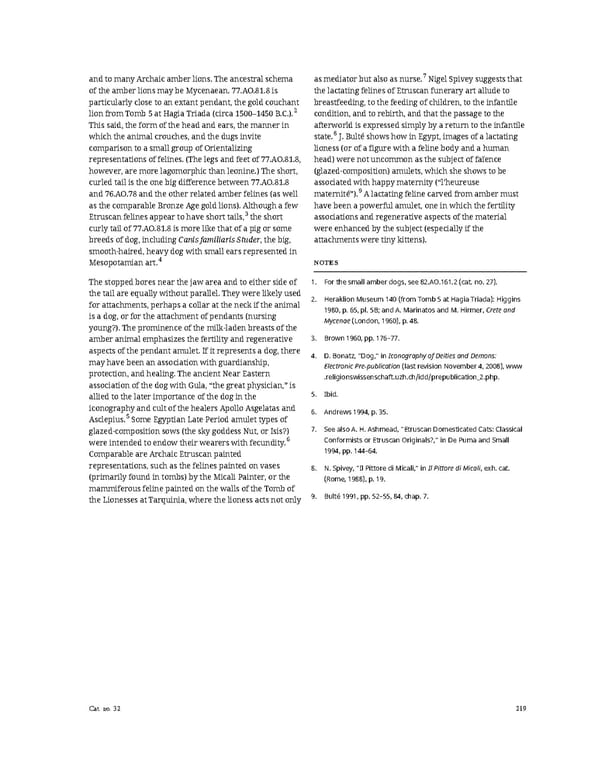and to many Archaic amber lions. The ancestral schema as mediator but also as nurse.7 Nigel Spivey suggests that of the amber lions may be Mycenaean. 77.AO.81.8 is the lactating felines of Etruscan funerary art allude to particularly close to an extant pendant, the gold couchant breastfeeding, to the feeding of children, to the infantile lion from Tomb 5 at Hagia Triada (circa 1500–1450 B.C.).2 condition, and to rebirth, and that the passage to the This said, the form of the head and ears, the manner in afterworld is expressed simply by a return to the infantile which the animal crouches, and the dugs invite state.8 J. Bulté shows how in Egypt, images of a lactating comparison to a small group of Orientalizing lioness (or of a figure with a feline body and a human representations of felines. (The legs and feet of 77.AO.81.8, head) were not uncommon as the subject of faïence however, are more lagomorphic than leonine.) The short, (glazed-composition) amulets, which she shows to be curled tail is the one big difference between 77.AO.81.8 associated with happy maternity (“l’heureuse and76.AO.78and the other related amber felines (as well maternité”).9 A lactating feline carved from amber must as the comparable Bronze Age gold lions). Although a few have been a powerful amulet, one in which the fertility Etruscan felines appear to have short tails,3 the short associations and regenerative aspects of the material curly tail of 77.AO.81.8 is more like that of a pig or some were enhanced by the subject (especially if the breeds of dog, including Canis familiaris Studer, the big, attachments were tiny kittens). smooth-haired, heavy dog with small ears represented in Mesopotamian art.4 NOTES The stopped bores near the jaw area and to either side of 1. For the small amber dogs, see 82.AO.161.2 (cat. no. 27). the tail are equally without parallel. They were likely used 2. Heraklion Museum 140 (from Tomb 5 at Hagia Triada): Higgins for attachments, perhaps a collar at the neck if the animal 1980, p. 65, pl. 5B; and A. Marinatos and M. Hirmer, Crete and is a dog, or for the attachment of pendants (nursing Mycenae(London, 1960), p. 48. young?). The prominence of the milk-laden breasts of the amber animal emphasizes the fertility and regenerative 3. Brown 1960, pp. 176–77. aspects of the pendant amulet. If it represents a dog, there 4. D. Bonatz, “Dog,” in Iconography of Deities and Demons: may have been an association with guardianship, Electronic Pre-publication (last revision November 4, 2008), www protection, and healing. The ancient Near Eastern .religionswissenschaft.uzh.ch/idd/prepublication_2.php. association of the dog with Gula, “the great physician,” is allied to the later importance of the dog in the 5. Ibid. iconography and cult of the healers Apollo Asgelatas and 6. Andrews 1994, p. 35. Asclepius.5 Some Egyptian Late Period amulet types of glazed-composition sows (the sky goddess Nut, or Isis?) 7. See also A. H. Ashmead, “Etruscan Domesticated Cats: Classical were intended to endow their wearers with fecundity.6 Conformists or Etruscan Originals?,” in De Puma and Small Comparable are Archaic Etruscan painted 1994, pp. 144–64. representations, such as the felines painted on vases 8. N. Spivey, “Il Pittore di Micali,” in Il Pittore di Micali, exh. cat. (primarily found in tombs) by the Micali Painter, or the (Rome, 1988), p. 19. mammiferous feline painted on the walls of the Tomb of the Lionesses at Tarquinia, where the lioness acts not only 9. Bulté 1991, pp. 52–55, 84, chap. 7. Cat. no. 32 219
 Ancient Carved Ambers in the J. Paul Getty Museum Page 228 Page 230
Ancient Carved Ambers in the J. Paul Getty Museum Page 228 Page 230